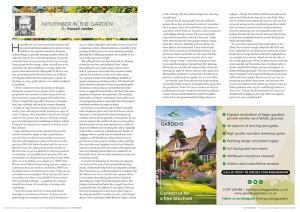
Hopefully the very warm and sunny summer will have provided ideal conditions for plants to have laid down the optimal cocktail of chemicals, in their foliage, to provide stunning autumn colour. In order for there to be a truly blazing display of autumn colour the leaves have to remain on the tree, or shrub, long enough for the orange, yellow and red hues to be revealed as the plant withdraws, or breaks down, the green colour derived from chlorophyll. If there is very wet and windy weather then the leaves can be blown off the plant before the best colour gets a chance to develop, so a nice, gentle, descent into colder conditions is beneficial.
On the subject of trees; the period of drought during the summer seems to have led to a higher proportion than normal of limbs being shed even from relatively young and apparently healthy trees. I have a Liquidambar styraciflua (American sweetgum tree) that suddenly split near the crown, dropping a couple of large branches, despite being less than twenty years old and previously showing no signs of stress or disease. This coincided with the first named storm of the season and, being in full leaf, a strong gust of wind exposed an underlying weakness which, I suspect, was created as a response to lack of water this summer.
Once deciduous trees have shed their leaves this month it would be timely to take a good look at any trees that you have in your garden just in case they have developed any cracks or fissures over the past year. With the limbs denuded and the tree in its dormant state, the approaching winter months are the best time to get a qualified tree surgeon involved to undertake any remedial work necessary. The one caveat here is to check that any tree due to have work done, or to be felled, is not subject to a ‘TPO’ (Tree Preservation Order) because doing any tree surgery to a protected tree can result in a hefty fine. TPO’s can be placed on trees by third parties, even if they are on your land or in your garden. They may pre-date your ownership so if there is any doubt it’s best to check with your local authority—a qualified tree surgeon should have plenty of knowledge of dealing with such things.
From trees come leaves! I’ve mentioned before how light accumulations of leaves, on lawns, can be gathered up by running over them with a lawnmower set on a high setting (this only works if your mower has a collecting system). Heavier deposits, especially if they are large, leathery, leaves are best raked up manually although leaf collecting machines are available if you have really large areas to rake.
The collected leaves are best dealt with by allowing to rot down in their own dedicated ‘bins’, rather than adding to your usual compost, because their lack of ‘greenness’ means that they rot down slowly and can be a hindrance to the more active nature of a ‘general’ compost bin. Sprinkling a handful of organic nitrogenous fertiliser, such as ‘fish, blood and bone’, between each layer of leaves may speed up the breakdown as the nitrogen, missing from the dead leaves, is supplied by the fertiliser and ‘feeds’ the micro-organisms that power decomposition. The resulting leafmould is a fantastic soil improver and mulch to use around specimen plants—especially those that require woodland conditions in order to thrive.
November to around the end of March, basically when deciduous plants have lost their leaves and are ‘dormant’, is the period when bare-root plants are available and should be planted in your garden. If you want to increase the number of trees in your garden, obtaining them as bare-root specimens is usually the most cost effective way of doing this and is especially useful when it comes to establishing new lengths of hedging. Now is a good time to research bare-root suppliers, you’ll find plenty online, because you’ve got the rest of the winter in which to plant anything that you order now. Suppliers tend to start lifting the material around now but will continue throughout the bare-root planting period whenever conditions are favourable (they can’t use their machinery in very wet or frozen ground).
It may be the beginning of the bare-root planting season but it’s the end of the spring bulb planting period. Traditionally tulip bulbs were planted no earlier than November, as a cultural method of avoiding ‘tulip fire’ disease, but I note that this once ‘gospel’ advice is now largely discredited and control is limited to discarding any tulips which develop the disease (the foliage is distorted and looks like it might have been scorched by fire). In addition, if any signs of disease have been noticed previously, do not plant tulips in the same ground for a number of years, as the fungal spores, from a pathogen called Botrytis tulipae, remain in the soil long after the infected tulips have been dug up and burnt.
I tend to divide spring bulbs into two different groups; those that are planted in order to ‘naturalise’, often in grass, where they will flower year after year and others which I treat as ‘annual’, used in containers and bedding schemes, where I do not necessarily expect them to perform after the first year. Tulips most often fit into the latter group whereas spring bulbs like crocuses, daffodils and snowdrops are more likely to be naturalised. I may well ‘recycle’ bulbs, from containers and bedding schemes, into permanent beds and borders in the hope that they may flower in subsequent years but this is very much ‘living in hope’, rather than relying on them to provide floral impact beyond their first planting. Obviously you should only replant bulbs which are showing no signs of disease and are still a good size. Mummified, withered or rotten bulbs should not be planted, something that’s equally true of new bulbs.
Last month I may have advised you to get anything not reliably hardy into pots and prepared for going into the greenhouse. Now’s the time to make sure all your tender perennials are moved into frost-free conditions. Cannas were probably lifted last month but dahlias can be left in the ground until the foliage begins to collapse—I’d get them lifted, labelled and under cover now even if their leaves have yet to turn black. They can be stored as bare tubers, all stems cut off and soil removed, as long as they are placed somewhere which does not freeze; cannas are best stored as dormant rhizomes potted up into non-watered compost (it’s hard to describe the fact that the rhizomes don’t want to desiccate completely but they mustn’t be kept wet while dormant either).
I’ve not really mentioned beds and borders so far. These days we don’t usually adopt the old ‘slash and burn’ approach, so even herbaceous perennials tend to be left alone, except for those that have collapsed into an unsightly mess and are ‘edited’ out for the sake of the overall appearance. If the weather remains relatively warm and dry, for November, then it’s still possible to do the standard ‘lift, divide, increase and replant’ on clump-forming perennials. This form of propagation is almost foolproof and congested herbaceous perennials will benefit from regular division even if you are not producing new plants from them. Any divisions that you do not replant can be potted up and given away to fellow gardeners who may be establishing borders of their own—I know that I’m going to have masses of ‘Goldenrod’ (Soildago) to gift away when I reorganise part of my own mixed border!



